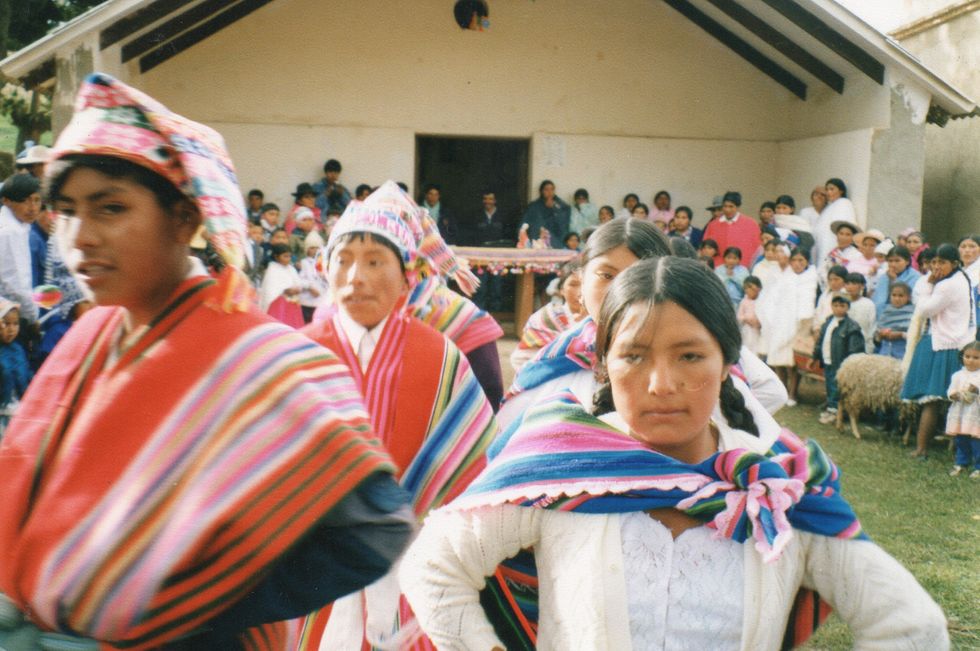The Quechua ("warm-valley") people originated in the grasslands region of the Andes known as Curahuasi. The dominant Quechua tribe of this region would become weakened by another tribe called the Chancas, and not long after, would be taken over by the Inca tribe and later Inca Empire. The Inca Empire consisted of a majority of the indigenous Quechua group, with a small percentage belonging to the indigenous Aymara group. The so-called empire included regions of what are now Ecuador, Peru, Bolivia, Chile, and Argentina.
A male citizen or puric in the Inca Empire wore a type of simple poncho made out of alpaca fur called an onka, paired with a colored woolen belt called a chumpi. Women also wore a simple dress called an anacu, which was a rectangular cloth woven out of alpaca fur. Quechua men today still wear a simple form of the poncho along with a chumpi, and women wear a type of peasant dress that mixes styles from Spanish colonial periods and precolonial periods. If a woman has a baby or small child, she will commonly wear an aguayo along with her dress, which ties in the front and creates a cradle for the child on her back. A style that recently arose in the 1920s is the usage of the bowler hat, brought by British railroad workers, and is still worn by Quechua (and Aymara) women today. Along with the bowler hat, Quechua men wear what is called a ch'ullu, which is a a knitted hat with ear flaps.
The Quechua people are called so because of the language they speak, but the Quechua language itself is known as Runa Simi ("the language of the people") to native Quechua speakers. In 1438, the Inca ruler Pachacuti made Quechua his language, and thus Quechua began to be used first in administration. Quechua was also recorded in messages using quipus, knotted ropes, which are thought to be mostly numerical recordings. Due to many conquests and interpreters or teachers of Quechua who had went along with these conquests, different dialects of Quechua arose in different regions, with the most common dialect spoken being the Southern Quechua dialect. Common phrases that are spoken include Ama sua, ama llulla, ama quella, which was a frequent greeting used in the Inca Empire and means, "Do not steal, do not lie, do not be lazy."
After the Spanish conquest of the Incas, the majority of the indigenous peoples were converted to Catholicism, yet certain beliefs and rituals remained. The Quechua people believed in many deities, including Viracocha (the great creator), Inti (the sun god), Mama Killa or Quilla (the moon goddess), and Pachamama (mother earth). By making offerings to the deities, the Quechua people believe they can influence certain events, such as making offerings to prevent bad weather for their crops. The Quechua people also believe that their religion plays two parts in their lives--one, that it promotes social unity among the Quechua people, and two, it connects the deities to the people.
As with every culture, certain myths or oral traditions are known and passed down to the Quechua people. Some of these myths include the myth of the white murderer known as Nak'aq or Pishtaco, who would suck the fat out of the indigenous people he killed, and the Wiraquchapampa myth, where the Q'ero, a community of Quechua peoples in the Cusco region of Peru, defeat the Spaniards. The myth of Incarrí, common to Southern Peru, tells about the last Inca to rebel against the Spaniards named Tupac Amaru, who was captured and beheaded by the Spaniards. The myth says that his body has been growing back, and when it fully grows back, the Incas will be able to return to their land.
Presently, many indigenous Quechua are migrating from their rural communities to the city to find opportunities for work, which was more accentuated starting in the 20th century. This increasing migration from community to city has resulted in a loss of Quechua identity and language. Along with loss of identity, many Quechuan people face ethnic discrimination in the cities, being alienated as they have differing lifestyles and culture.






















